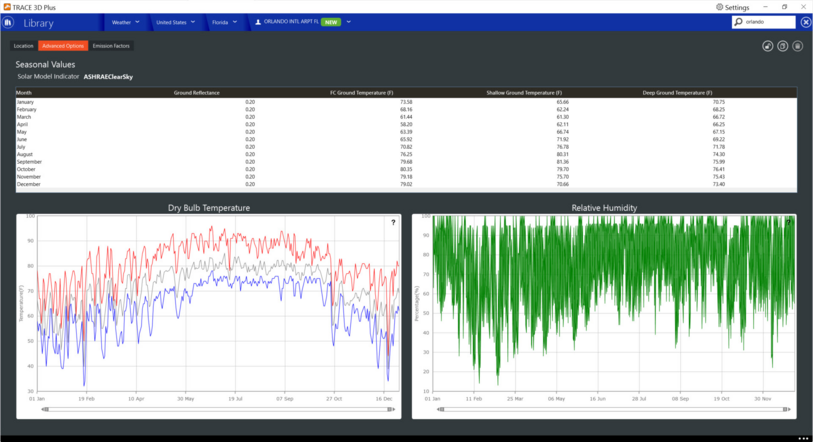Advanced Options
The Advanced Options tab allows you to modify some seasonal values as well as to see the dry bulb and wet bulb temperature profile.

|
Seasonal Values
|
|
|
|
|
|
|
|
|
|
|
|
|
|
|
|
|
|
|
|
|
|
|
|
|
|
|
Solar Model Indicator
Three options are available to calculate the solar radiation in the design day.
-
ASHRAE Clear Sky and Zhan-Huang (both use the clearness value).These two options are available only if the Design Weather source is the custom file.
-
ASHRAE Tau is available only when Design Weather source is ASHRAE Climatic Data. It uses the Taub and Taud values according to the model in ASHRAE HOF 2009, Chapter 14.
Depending on the Solar Model Indication selected, you will have access to several features from the location selected.
ASHRAE Clear Sky
This is the default model selected and it is used to estimate hourly clear day solar radiation for every month for both northern and southern based on the model described in ASHRAE HOF 2005 Chapter 31 and updated in ASHRAE HOF 2009. This model usually over-estimates solar radiation in the building.
Zhang-Huang
This solar model was created to be used to create meteorological years for China weather sites. It uses cloud cover, dry bulb temperature, relative humidity and wind speed as independent variables to calculate solar radiation therefore it can be used for other locations too.
ASHRAE Tau
This is a revised clear Sky model presented in ASHRAE HOF 2009 based on optical depths for direct and diffuse radiation values created by month for all ASHRAE locations.
Some ASHRAE studies show that this model provides more realistic irradiance values than the Clear Sky model.
Clearness Number
This field is only available for ASHRAE Clear Sky and Zhang-Huang solar models. It represents the clearness value for the design day which is used to obtain the solar radiation for each hour. It can be determined for each month.
|
Default: 0.2
|
|
Min & Max: 0.0 to 1.2
|
|
Typical Range: A clear sky at sea level would be represented by a 1.0 value and locations with higher altitudes could use a value greater that 1.0
|
|
Units: N/A
|
Ground Reflectance
This field is used to calculate ground reflected solar, GroundReflectedSolar, value per month (12 fields). If a value of 0.0 is used no ground reflected solar is used for that month’s timeframe.
|
Default: 0.2
|
|
Min & Max: 0.0 to 1.0
|
|
Typical Range: 0.0 to 1.0
|
|
Units: N/A
|
Ground FC factor Method
This field is only used for underground walls, and slab-on-grade or underground floors defined with C-factor. The monthly ground temperature shown for the FC Factor should be close to the monthly average of the outside air temperatures delayed by three months for a given location. This is detailed in EnergyPlus references as Site:GroundTemperature:FCfactorMethod.
|
Default: 55.4°F / 13°C
|
|
Min & Max: -130 to 158°F / -90 to70°C
|
|
Typical Range: 60 to 120°F / 15 to 48 °C
|
|
Units: °F / °C
|
Shallow Ground Temperature
This value is used to determine the outside surface temperature.
Default value: 55.4°F or Temperature that corresponds to the 0.5 meter depth monthly ground temperature value from the selected epw file.
|
Min & Max: -130 to 158°F / -90 to70°C
|
|
Typical Range: 60 to 120°F / 15 to 48 °C
|
|
Units: °F / °C
|
Deep Ground Temperatures
This field determines the outside deep ground temperature. Default value: 60.8°F or temperature that corresponds to the 4 meter depth monthly ground temperature value from the selected epw file. This value is used to represent undisturbed soil of typical conditions.
|
Min & Max: -130 to 158°F / -90 to70°C
|
|
Typical Range: 60 to 120°F / 15 to 48 °C
|
|
Units: °F / °C
|
Temperature Graph
Daily dry bulb and wet bulb temperature values from the epw file selected. Scroll to zoom, click and drag to select a specific period of time or enlarge both the graph and the table. Daily high, average, and low are indicated by the three lines.